Hot Topics
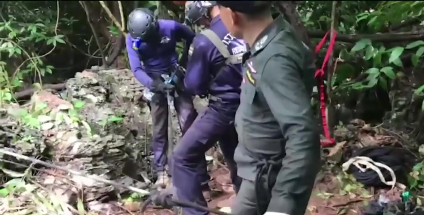
- Details
- Written by: Quintus Potgieter
- Category: Hot Topics
Elon Musk, as we know, is a renowned billionaire responsible for behemoth engineering companies such as Tesla Motors and SpaceX. He has also shown a tenacious attitude towards figuring out complex problems using his engineering prowess, as world events occur.
He recently, in a string of two tweets, said:
“Engineering is magic. Or at least the closest thing to magic that exists in the real world.”
And it’s that same magic that humans employ when disaster strikes.
Elon tweeted that statement on the 29th of June. On the 2nd of July news rang out across the globe that 12 teenage soccer team boys and their coach were stuck in a cave in the Chiang Rai Province in Thailand.
On the 23rd of June, the boys ventured 2,48 miles into a cave named the Tham Luang Nang Non underground cave complex after one of their soccer games. They became trapped after torrential rain flooded the cave.

To make matters worse further downpours were expected due to the treacherous monsoon season that descends on the area annually.
There was some relief when the group was found alive, but when a former Thai Navy SEAL died in the cave due to a lack of oxygen it became clear that the rescue mission would have to be extraordinary.
Elon Musk began tweeting about the technology he thought would assist the rescue operations. What followed was a torrent of suggestions from engineering professionals, all offering their two cents worth on what could be done, as rescuers worked against the clock.
Elon tweeted:
“I suspect the Thai government has this under control, but I’m happy to help if there is a way to do so. Boring Co has advanced ground penetrating radar and is pretty good at digging holes. Don’t know if pump rate is limited by electric power or pumps are too small. If so, could dropship fully charged Powerpacks and pumps.”
Musk’s first idea included drilling down into the cave and potentially lifting from the top - reminiscent of the Chilean Miner Rescue of 2010. Another idea included taking an inflatable nylon tube and weaving it through the cave, providing a waterproof escape route through the cave.
But then they came up with an idea that could be used for future cave rescues. Elon tweeted:
“Building double-layer Kevlar pressure pods with Teflon coating to slip by rocks and front/rear rope tow hitch and lead pockets for neutral buoyancy. ~60 cm oval. Testing this afternoon in a pool with a subject who has never done SCUBA. Do the divers think something like this might work? Probably wise to add an air tank (butt end foward to take impacts) in nose of pod and vent valve in rear. Set air tank to slow bleed rate, then no need for SCUBA mouthpiece or regulator. Training unnecessary and less susceptible to panic attack.”
They eventually ended up sending SpaceX and Boring Co. engineers to Thailand on the 7th of July to see if they could somehow assist the Thai government. Musk was ready to build a kid-sized submarine out of SpaceX rocket parts.
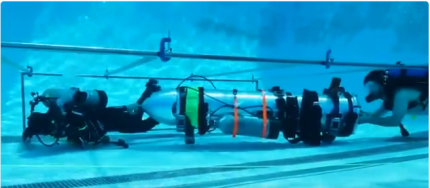
Meanwhile the SpaceX team built and experimented with a metal tube in a swimming pool in Los Angeles. However, news soon emerged that the dive teams could no longer delay the rescue because of forecast rains. On the 7th of July it was announced that the rescue mission was to commence. We’ll never know if Musk’s prototype could have worked, but perhaps it can be perfected for future rescue missions.
After being trapped for 15 days the rescue began. At the time of the writing of this article eight boys had been freed from the cave, leaving four boys and the coach waiting on their small sandy island deep inside.
Four boys were extracted at a time, with each one wearing a full-face diving mask and each one being guided through the labyrinth of caves and waterways by an expert diver.
John Volanthen, the lead diver on the Thai Cave Rescue said:
“I dive for passion and always wondered if it would have a purpose. The last two weeks was what I prepared for my entire life.”
Works Cited
“Elon Musk and His Engineers Develop Mini Kid-Sized Rescue Sub to Extract Soccer Team Stranded in Thai Cave.” Interesting Engineering, 8 July 2018, interestingengineering.com/elon-musk-and-his-engineers-develop-mini-kid-sized-rescue-sub-to-extract-soccer-team-stranded-in-thai-cave.
Musk, Elon. “Maybe Worth Trying: Insert a 1m Diameter Nylon Tube (or Shorter Set of Tubes for Most Difficult Sections) through Cave Network & Inflate with Air like a Bouncy Castle. Should Create an Air Tunnel Underwater against Cave Roof & Auto-Conform to Odd Shapes like the 70cm Hole.” Twitter, Twitter, 6 July 2018, twitter.com/elonmusk/status/1015105500105412610.
- Details
- Written by: Quintus Potgieter
- Category: Hot Topics
Ahead of the International Conference on Robotics and Automation in Brisbane, Australia, a group of engineers from the University of Washington have announced something that might have tongues wagging at the conference.
They are releasing a study they have conducted that will show the feasibility of wireless, flying, robot insects.
Looking like something out of the film ‘Eye in the Sky’ the engineers have created the world’s first wireless flying robot insect. The engineers have said this is “one small flap for a robot” and “one giant leap for robot-kind”.
The video they have released shows the robot flapping its wings quicker than the eye can see. When slowed down, the robot’s wings look eerily similar to that of a fly’s wings. And have aptly dubbed the robot, ‘RoboFly’.
How it flies
The methodology behind how it flies (how it is powered) is impressive. The engineers have devised a scheme whereby a laser beam is pointed at a photovoltaic cell positioned on the fly’s back.
The assistant professor who co-authored the study, Sawyer Fuller, works in the University of Washington’s Department of Mechanical Engineering. He said:
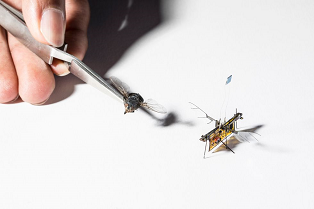
“Before now, the concept of wireless insect-sized flying robots was science fiction. Would we ever be able to make them work without needing a wire? Our new wireless RoboFly shows they’re much closer to real life.”
Enlisting the expertise of the Electrical Engineering department at UW, the robot utilizes a specially designed circuit that takes the current being produced by the laser beam and the photovoltaic
Johannes James, the lead author, explains how the wings use all of the produced energy:
“To make the wings flap forward swiftly, it sends a series of pulses in rapid succession and then slows the pulsing down as you get near the top of the wave. And then it does this in reverse to make the wings flap smoothly in the other direction.”
Refining how the fly uses its wings will be the main focus going forward. Because of its size, the robot is unable to use any other method of levitating - the wings are its only low-weight solution. Nonetheless, the progress that the University of Washington’s engineers
“You could buy a suitcase of them, open it up, and they would fly around your building looking for plumes of gas coming out of leaky pipes. This is inspired by real flies, which are really good at flying around looking for smelly things. So we think this is a good application for our RoboFly.”
Developing these kinds of robots is important
Works Cited
Grossman, David. “Watch a Laser-Powered Robotic Fly Take Its First Flight.” Popular Mechanics, Popular Mechanics, 16 May 2018, www.popularmechanics.com/technology/robots/a20717355/robotic-laser-fly/.
“Wireless Robot Fly Undertakes First Independent Flight.” Interesting Engineering, 17 May 2018, interestingengineering.com/wireless-robot-fly-undertakes-first-independent-flight.
- Details
- Written by: Quintus Potgieter
- Category: Hot Topics
If you start an engineering company today a lot of your operations - both on-site and at the enterprise levels of your business - are vulnerable to being hacked. This is due to the number of technologies which are connected to a cloud-based or internet-connected framework.
The infrastructural technologies of the world are not the only entities under attack - the data the technologies generate and the general data that

The topic of data protection became compelling when companies like Facebook - who have the data of more than 1 billion people - allowed data to be sold to bidders. The issue, therefore, needs to be two-pronged; companies need to establish an ethical approach to handling data and a new band of engineers, the data protection engineers, need to carefully secure data so that it cannot be stolen.
Protecting individuals
Whilst complex security solutions for utility-scale technologies are designed and implemented, individual data - that we humans freely give to every new app that emerges - is undergoing new levels of protection.
You may have received an onslaught of emails recently from the services you have signed your data away to. This would have been due to the European Union’s new General Data Protection Regulations (GDPR). And whilst it may seem that only Facebook and Twitter need comply with the regulations, the company you work
The regulations insist companies have clarity on the location of their stored data and who has access to it. The personal data of individuals within companies has to be adequately protected unless they want to risk being fined by the relevant authorities.
Companies doing business with clients and customers in the European Union need to, as PricewaterhouseCoopers puts it, “make changes to their data privacy, technology and oversight processes”.
Similarly, those investing in a company need to be protected.

Under the new regulations, individuals may ask a company to remove any of their details from databases unless their details are legally required.
If a cyber-attack occurs, and data is compromised, a company must alert authorities within 72 hours.
The new regulations essentially ensure a client’s right to be forgotten when they cease being a client. The party involved can contact the company and ensure that all traces of their data are eradicated from all servers the company has.
Non-compliance could lead to fines of up to 4% of a company’s annual worldwide revenue. PwC reports that in the United States, 3 in 4 companies will invest up to US$1 million in an effort to be GDPR compliant.
Companies who believe they already have a reasonable level of protection for the personal data of their staff and clients can rest easy for now.
Works Cited
Nadeau, Michael. “What Is the GDPR, Its Requirements and Deadlines?” CSO Online, InfoWorld, 23 Apr. 2018, www.csoonline.com/article/3202771/data-protection/general-data-protection-regulation-gdpr-requirements-deadlines-and-facts.html?page=2.
PricewaterhouseCoopers. “SA Companies Doing Business with EU Customers Need to Consider Making Changes to Their Data Privacy.” PwC, www.pwc.co.za/en/press-room/sa-companies-
- Details
- Written by: Elyse Simich
- Category: Hot Topics
We have been asking EIT’s resident engineers to share with us the object that inspired their engineering career or the tool that has helped them the most throughout their career.
Below is a video of EIT’s Dean Steve Mackay telling us about the book that ignited his passion for engineering as a child.
Now we want to hear from you! Post a photo of yourself with the object that inspired you to study engineering or the tool you’ve found most useful throughout your career on Facebook or Instagram. Don’t forget to use #eitoncampus and tag us in your post. We are giving away one $50 Amazon gift card every week to our favourite entrants.
**T&Cs: This is in no way sponsored, administered or associated with Facebook or Instagram. By entering, entrants confirm they are 13+ years of age and agree to Facebook and Instagram’s terms of use. Entrants also consent to EIT reposting the photo on our social media channels. We will be selecting one winner each week until DATE**
- Details
- Written by: Ruth Kennedy
- Category: Hot Topics
It was once the stuff of science fiction novels and films, but artificial intelligence and robot sentience are here and developing fast. A range of experts are responsible, including engineers.
This burgeoning reality is presenting the world with advantages that cannot be understated, but we also need to remain vigilant.

Science fiction has presented us with a number of negative scenarios which have entertained us, but knowing that fact is sometimes stranger than fiction it is worth remaining wary. Do we want to entrust the operation of our important infrastructure to sentient machines?
Enter a new documentary entitled ‘Do You Trust This Computer?’ The 2018 documentary questions the internet-connected, artificially intelligent technologies that are increasingly capable of harvesting our data.
Do we really have a handle on how this will all unfold?
Rapid advancement
The speed at which technology is developing is causing chaos for those who are neither agile nor flexible enough to keep up. As we know, jobs involving repetitive tasks are being replaced by clever machines which are able to work relentlessly and tirelessly.
Whilst there have been no worker protests over robot replacements in the assembly line, the same cannot be said for autonomous vehicles. Taxi companies are up in arms. The reality is that a computer will inevitably become more skilled than a human driver. It will not succumb to distractions, or to tiredness and it will not battle slow reflexes. The future will see fewer vehicle-related fatalities.
The medical industry has also been taken by storm. Computers are reading mammograms, they’re diagnosing diseases and offering treatments (in many cases more efficiently and accurately that doctors).
Hello, Robot Overlords
At the very beginning there was a question that would ultimately define the concept of AI.
The question was: Can a computer think?
Dutch computer scientist and 1972 Turing Award winner Edsger W. Dijkstra replied with, “Can a submarine swim?”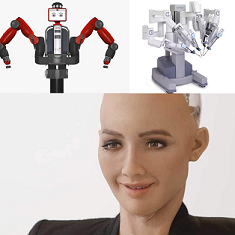
A submarine is engineered around the basic principles of marine life. It then goes on to improve on nature by being more robust than a marine creature - it has a harder exterior ‘shell’. It also trumps the swimming speed of marine creatures. It has in fact, surpassed the natural world.
Similarly, with the basic principles of thought installed in computers, and becoming increasingly refined, is AI poised to surpass the capacity of our human brains? In many instances it already has and will strengthen as quantum computing powers up.
These examples show how remarkably capable and cognitive robots have become: Baxter is replacing workers on the assembly line. The biomedical DaVinci robot is performing precise surgeries and with each operation improving its capabilities; essentially learning from experience. Sophia the Robot is having intelligent conversations with interviewers.
The future has become the present.
Autonomous weapons
More alarming is the impact on warfare; drone technology has emerged and with AI capability are scanning territories as they fly.
Peter Singer, the author of ‘Wired for War’, says there are 10,000 automated drones in the U.S. military - with 80 other countries also operating automated weapon-fitted drones. Essentially an automated, AI-powered arms race is heating up. 6,000 concerned senior engineers and scientists have drafted an open letter to AI industry leaders; to highlight the dangers of AI development.
Elon Musk and Stephen Hawking were among the signatories.
Engineers and scientists are determined that technologies powered by AI should promote the wellbeing of life on planet earth. Elon Musk explains that AI could, even without evil intent, make seemingly irrational decisions because of its capacity to learn. He says:
“AI doesn’t have to be evil to destroy humanity. If AI has a goal, and humanity just happens to be in the way, it will destroy humanity as a matter of course. Without even thinking about it, no hard feelings. It’s just like, if we’re building a road - and an anthill happens to be in the way - we don’t hate ants, we’re just building a road. And, so, goodbye anthill.”
A robot takeover - ala-Terminator 2 – is, thankfully, not likely in the near future. But a little more transparency around the development of machine learning algorithms is required.
Students at Carnegie Mellon University have been working on a standard for ‘algorithmic transparency’. Anupam Datta, an Associate Professor of Computer Science and Electrical and Computer Engineering at the university, explains:
“Some companies are already beginning to provide transparency reports, but work on the computational foundations for these reports has been limited. Our goal was to develop measures of the degree of influence of each factor considered by a system, which could be used to generate transparency reports.”
Transparency will soon be the name of the game. And for engineering industries that make the world go round and whose inventions deeply impact human life, perhaps that’s a good thing.
Works Cited
“Do You Trust This Computer? (2018).” IMDb, IMDb.com, www.imdb.com/title/tt6152554/.
Potgieter, Quintus. “Engineers conduct studies on artificial intelligence and its machine-learning practices.” Start Here..., engineeringcareer.org/news/348-engineers-conduct-studies-on-artificial-intelligence-and-its-machine-learning-practices.html.
- Details
- Written by: Quintus Potgieter
- Category: Hot Topics
As the northern hemisphere looks forward to a much deserved summer, innovators in engineering and technology are looking to make subsequent winters a little less hazardous for some.
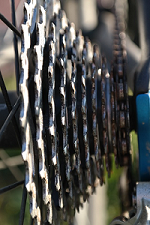
The engineering students at the University of Calgary in Canada are devising ways to keep cyclists and their bicycles safer during the winter months. Apart from the challenges of controlling bikes on pathways that are iced over, cyclists struggle with their gear systems which are also affected in snowy conditions.
When temperatures plummet salt is used to keep the ice off the roads. But it is also sand and grit which get into the derailleur gears (the gears that keep the bicycle moving), and can cause chaos. Lubricating the gears with oil doesn’t help either - it just attracts more dirt.
In general, the metal components of bicycles are in danger of rust and other forms of damage during winter in the northern hemisphere. After a winter of riding, a bicycle basically needs to be fully repaired, with new parts fitted to the frame.
“Winter riding can take a toll on the bicycle, especially if you have a traditional derailleur system. It tends to wear out due to corrosion, and due to gravel being stuck in the chain which causes these gears to chip.”
Those are the words of Calgary engineering student Parth Thakurdesai, speaking to Calgary Eyeopener. He and three other students (Evan Magnusson and Nazanin Moghtaderi, and Alex Robertshaw) have engineered a ‘hub of gears’. They claim it will ensure bikes remain free of corrosion and general damage during and after an icy and wet winter season.
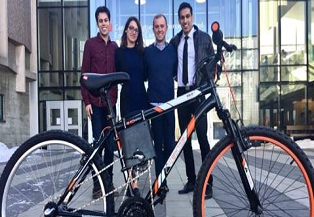
The invention involves connecting the chain to a ‘triangle formation’. The chain goes from the pedals, to a gear hub and then back to the wheel. An encasement protects the gear hub from the weather conditions and prevents dirt from entering the gears.
To test their new invention, the engineers iced up the gears, and then took the bike for a spin. It turned out that they were able to move between gears with ease. In the same icy conditions the traditional derailleur gears would not have been able to shift between gears. In winter conditions many bikers give up and opt to put robust tires on their bicycles.
The students have every intention of further developing their gear system. They will test their improvements over a number of winters before commercializing it.
Works Cited
“Calgary Eyeopener.” CBCnews, CBC/Radio Canada, www.cbc.ca/listen/shows/calgary-eyeopener/.
“U Of C Students Make New Gears to Improve Winter Biking | CBC News.” CBCnews, CBC/Radio Canada, www.cbc.ca/news/canada/calgary/winter-biking-university-of-calgary-1.4606559.
- Details
- Written by: Elyse Simich
- Category: Hot Topics

In support of Global Day of the Engineer , we are celebrating the positive impact engineers have had on our world as we know it. Engineers aren’t just responsible for building giant skyscrapers or inventing cutting-edge technology – without engineering there would be no civilisations or infrastructure, agriculture, vehicles, tools or technology.
At a very basic level, engineers combine principles of maths and science to solve problems by adapting natural resources to suit our needs. Levers, pulleys, wheels, wedges and the inclined plane were some of the first tools invented, with the aim of decreasing the effort required to lift and transport heavy loads. Engineers first emerged in ancient times, building cities, complex water systems, walls, temples and pyramids – the first engineer known by name is Imhotep, builder of the Step Pyramid in Saqqara, Egypt in approximately 2550 BC.
Since then, the profession of engineering has advanced significantly. The original core disciplines of civil, mechanical, chemical and electrical have been complemented by newer fields such as software, computer, nanotechnology, molecular and mechatronics. These disciplines work hand-in-hand to ensure our everyday life continues to run smoothly, in ways most people would take for granted on a daily basis.
Civil engineering makes the existence of infrastructure possible. Without it buildings, roads, bridges, canals, tunnels, water systems, dams and railways would cease to exist. This would leave us exposed to the elements, with no structures to protect us from wind, rain, sun and extreme temperatures. Travelling would be virtually impossible without roads, railroads, airports, bridges, tunnels and canals. Living near a clean freshwater source would be imperative for survival, as there would be no pipes to transport water. Illness would be much more prevalent, as sewage systems wouldn’t exist.
Mechanical engineering has given us vehicles such as cars, trains, aeroplanes, ships and space crafts, which enable us to explore the world and the universe around us. Without mechanical engineers, we wouldn’t even have bicycles, so we’d have to travel everywhere on foot. It would also be impossible to manufacture anything, as factories wouldn’t exist. The only means of cooking would be on a natural open-fire, lit by stones and built solely out of wood. There would be no medical technology, such as X-rays and CT scanners, let alone life-support machines and mechanical limbs or organs. Every machine you can think of would never have been invented without mechanical engineers.
Without electrical engineers, there would be no knowledge of how to convert natural resources into electrical energy, so we would live in a world without power. Environmental engineers ensure compliance with environmental law and aid in the clean-up of hazardous waste, which keeps us and our planet safe. Computers, their software and computer games wouldn’t exist without computer and software engineers.
Humans have achieved amazing things such as space exploration, the discovery of new particles, and the creation of advanced biomedical technologies, self-driving vehicles, virtual reality and 3D printing. Without engineers, our world today would not be possible.
Sources:
https://www.manufacturing.net/blog/2014/02/what-world-would-be-if-engineering-didnt-exist
https://www.britannica.com/technology/engineering
- Details
- Written by: Quintus Potgieter
- Category: Hot Topics
E-commerce: the buying and selling of items over the internet. People around the world are using this purchasing platform at a rate that individual companies can barely keep up with. Thankfully there are a host of companies who specialize in transportation and logistics. Even so, to adequately cope, these companies need to automate their technologies, including the heavy lifting, so that they can spend real manpower on customers.
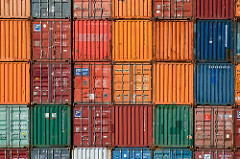
Most people embracing E-commerce don’t consider the immense engineering challenges that it presents.
Through continued innovation and automation, products are transported ever more efficiently and expeditiously. An item purchased by a customer often sees a warehouse, a shipping container, and two delivery and logistics companies, before reaching its destination.
Automated ports
The ports around the world, handling an increasing number of shipments, are investing in automation engineers as they increasingly mechanize their processes.
Container automation has become a focus for logistics companies in the last five years. One of the world’s first fully automated container terminals is in Qingdao, eastern China. The system can unload 1,785 containers in 9 hours.
The plant recently made a new world record for average crane moves per hour; it performed 39.6 moves in one hour. There are no lunch breaks for an automated crane operator! An automated port is able to achieve 30 percent more productivity than a fully manned container terminal.
The United States is also automating container terminals; the Port of Los Angeles’ TraPac terminal employs automated cargo-haulers and automated stacking cranes. The port is one of the very first in the US to be experimenting with automated technology.
Norway is also pioneering automation in the logistics space – it is engineering the world’s first automated container ship. The ship, the ‘Yara Birkeland’ is set to be released this year.
From port to portables
XPO Logistics is the fastest growing Fortune 500 company specializing in transport and logistics. It spends close to US$500 million on developing new technologies for the industry every year.
The company understands that delivery efficiency is the key.
CEO of XPO Logistics, Brad Jacobs, says that the 750 warehouses that the company owns have become high-tech hubs. Robots do the heavy lifting, drones take the inventory, the staff use internet-connected wearables. In general automation replaces humans in the more repetitive tasks. Speaking to Fortune, he said:
“We’re actually the largest manager of expedited shipments in the world. These are critical, urgent, unplanned shipments that have to be delivered right away. Usually they are picked up in 45 minutes and delivered in a couple of hours and we usually do that by truck, we also do it by plane, we also do it cross-continentally.”
The company has just introduced a new warehouse management system, optimized for mobile devices: WMx technology. It is a cloud-based system which ensures efficient internal communication – personnel merely log in to locate specific information.
As the industry heats up, companies like Uber are trying to enter the freight business as well. They’re trying to mobilize drivers to deliver items around their cities, suburbs and towns.
In fact E-commerce is available to anyone willing to service the eager, paying customers in all corners of the world. The competition is fierce, however, and efficiency is king, but with automation expertise gathering steam the deftness and speed of delivery is almost poised to defy logic.
Works Cited
“U.S. Ports Take Baby Steps in Automation as Rest of the World Sprints.” Fortune, fortune.com/2018/01/30/port-automation-robots-container-ships/.
“World's Most Efficient Fully-Automated Port in E China.” YouTube, 3 Dec. 2017, youtu.be/4AF9aIgUj3Q.
- Details
- Written by: Quintus Potgieter
- Category: Hot Topics
March 2018 will go down in history as a tough month for autonomous and electric vehicle engineers.
Self-driving cars and the engineering technologies that power them are being heavily criticized due to a spate of high profile failures and the dangers of introducing job-threatening ideologies into the modern world.
A self-driving Uber SUV in Tempe, Arizona, struck and killed a pedestrian on the evening of March 18th, 2018. The Volvo XC90 was in the autonomous mode at the time of the accident. This is despite Uber using ‘safety drivers’ to guard against accidents.
Public opinion is divided over what or who to blame: the self-driving technology or the safety driver (who was not paying attention to the road at the time of the crash)? According to the exterior and interior cameras in the self-driving SUV, however, it is clear that the car’s technology would have been unable to prevent the crash.
(Tesla’s autopilot mode has also caused accidents before, one being fatal.)
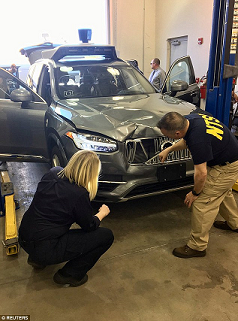
As a result of the SUV crash Uber removed all of its self-driving vehicles from Arizonian roads. (Uber had also been hiring drivers with criminal records; they have changed that strategy too).
Toyota also halted self-driving car tests after news broke of the Uber accident. Toyota, like Tesla Motors, has a driver-assisting technology; the technologies are somewhat different to the fully autonomous methods used in Uber’s case.
Despite the tragedies Toyota is launching a US$2.8 billion company to continue developing the self-driving technologies.
Self-driving cars are being viewed with heightened skepticism, understandably, but then so too are the renewable technologies that are powering the electric vehicles of the present and future.
Electric Vehicles in the firing line
A Tesla Model X was involved in a crash on the 23rd of March 2018. The Model X crashed into a median barrier on Highway 101 in Mountain View, California (Silicon Valley). The car burst into flames. Whether or not the autopilot function had been enabled is beside the point - the flames were reportedly coming from the battery.
NBC’s Bay Area twitter account tweeted: “A Good Samaritan at the scene of the Tesla Model X car crash described the car to be “actively emitting full flames from the battery bank.”
It is suspected that when an electric vehicle (EV) crashes the threat of a fire starting on impact is real. The battery banks on a Tesla Model X’s are made up of 7,000 cells. If the cells catch fire, they can burn at 900 degrees Fahrenheit (482 degrees Celsius).
However, Elon Musk’s Tesla Motors has defended itself: with indications that lithium-ion powered vehicles could catch fire they are still 5 times less likely to catch fire in crashes when compared to gas-powered vehicles. Nonetheless, at the scene of the crash firefighters and Tesla technicians worked together to figure out how to effectively douse the fire. It was an interesting meeting of minds: firefighter and technician.
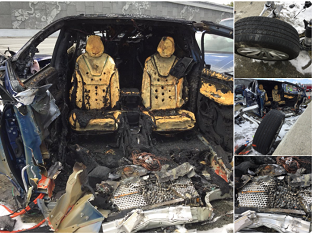
The concern is that police and emergency services are not equipped to handle situations caused by newer technologies they do not yet understand. EV technology has been challenging engineers and technicians for some time, but now emergency service personnel are on a sharp learning curve too.
Autonomous vehicles and EVs have come a long way, but ultimately safety is paramount. It is, however, also worth reflecting on the turbulent history of the driver-dependent, gas-powered vehicle.
Works Cited
“Arizona Puts Brakes on Uber Self-Driving Car Tests.” Phys.org - News and Articles on Science and Technology, phys.org/news/2018-03-arizona-uber-self-driving-car.html.
Fingas, Jon. “Tesla Model X Driver Dies in Mountain View Crash.” Engadget, 26 Mar. 2018, www.engadget.com/2018/03/24/tesla-model-x-driver-dies-in-mountain-view-crash/.
- Details
- Written by: Quintus Potgieter
- Category: Hot Topics
Modern dam engineers in Africa could inadvertently trigger a water war in Africa.
It all started when Egypt was distracted by a governmental crisis - the Arab Spring Uprising was consuming most of the attention of the tenuously positioned Egyptian Government. At this juncture the Ethiopian government mobilized its dam engineers to begin work on a project to create hydro power.
So began a hydro-politics disagreement that Egypt says may lead to a war.
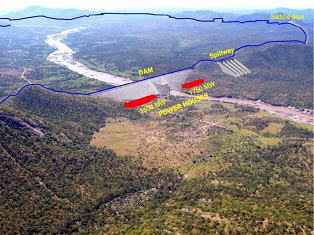
The Ethiopian project involves damming one of Africa’s greatest sources of water; the River Nile. By harnessing this river the Kingdoms of Egypt, Ancient and New, were enabled. And modern Egypt is still very reliant on its water. Ethiopia’s industrialization and modernization, however, continues, and as it does, there is a growing demand for electricity. The government plans to have this source of power as part of their future energy mix.
More than 80% of Egypt’s water is provided by the Blue Nile which flows from Ethiopia. The proposed Grand Ethiopian Renaissance Dam (GERD), destined to be filled by water from the Blue Nile, may impact on Egypt.
The dam has been under construction since 2011. The entire project will cost Ethiopia US$5 billion - roughly 15% of the country’s GDP as recorded in 2012 (and 60% of its annual budget).
Egypt is rightly concerned that their water source may be disrupted by the GERD. The success of agriculture in Egypt is still dependent on the Nile, as it was in ancient times. If their scant rainfall levels drop and the filling of the dam begins Egypt could run dry.
Upon its completion, the GERD will be the biggest dam in Africa. It will be 1,800 meters long, 155 meters high, and will hold 74 billion liters of water. The project, as of 5 months ago, was 60% completed. It is expected to be operating by the end of 2018.
Ethiopian sources say the hydro power setup (including 16 hydroelectric turbines) will neither divert nor disrupt the water that is Egypt-bound. Experts, on the other hand, are worried that when the dam begins filling it could cut off Egypt’s water supply for a full year; unless, of course, it is filled very slowly indeed.
The middleman and the naysayers
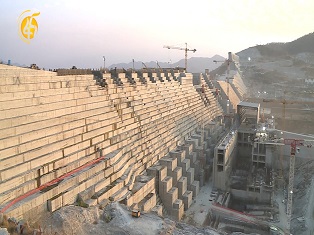
The African country right in the middle (figuratively and literally) of the Ethiopian and Egyptian water dispute, is Sudan.
Sudan is siding with Ethiopia. The benefits for them include a potential strengthening of their already strong agricultural output and they hope to share in the electricity generated by the turbines at the GERD. Being outnumbered two to one Egypt would struggle to prevent the completion of the GERD.
Resources Ministers from the three African countries have been engaged in talks to settle concerns, but to no avail. Egypt has appealed to the UN Security Council to intervene, but the matter has again been referred to the leadership of the countries involved.
BBC News spoke to Osama Daoud Abdellatif, head of the DAL Group, a group that operates farms and irrigation setups in Sudan. He said:
“For Sudan, it’s wonderful. It’s the best thing that’s happened for a long time and I think the combination of energy and regular water levels is a great blessing.”
Engineering professionals, however, warn that the estimated figures published around the impact of the GERD on electricity output may be a little off. Asfaw Beyene, a Professor of Mechanical Engineering at San Diego State University, speaking to International Rivers said:
“More than half of the turbines will be rarely used. GERD’s available power output, based on the average of river flow throughout the year and the dam height, is about 2,000 megawatts, not 6,000. There is little doubt that the system has been designed for a peak flow rate that only happens during the 2-3 months of the rainy season. Targeting near peak or peak flow rate makes no economic sense.”
Works Cited
“The 'Water War' Brewing over the New River Nile Dam.” BBC News, BBC, 24 Feb. 2018, www.bbc.com/news/world-africa-43170408.
“The Grand Ethiopian Renaissance Dam Fact Sheet.” International Rivers, www.internationalrivers.org/resources/the-grand-ethiopian-renaissance-dam-fact-sheet-8213.
- Details
- Written by: Quintus Potgieter
- Category: Hot Topics
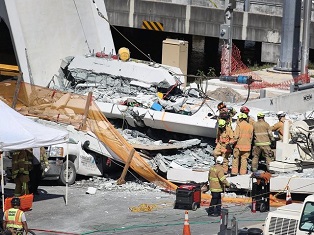
The Sweetwater University City Pedestrian Bridge collapse at Florida International University is the latest civil engineering failure making headlines around the world.
Figg Bridge Engineers discussed a crack that had formed on the new bridge hours before its demise, but “concluded there were no safety concerns and the crack did not compromise the structural integrity of the bridge.”
Despite these assertions it did collapse and caused six fatalities and further injuries. Vehicles were pancaked underneath the rubble, as the photograph here depicts.
Lead engineer on the project W. Denney Pate had sent a voice mail to the Transportation Department; he reported the “cracking” that was observed on the “north end” of the bridge. The voice mail was sent two days before the bridge came crashing down.
Pate did say, in his professional opinion, the cracking “from a safety perspective” was not something they were concerned about. The cracking did not indicate that a collapse would follow. The engineering firm even did a stress test a few days before the collapse. All tests performed failed to raise any urgent red flags.
A civil lawsuit has been filed for gross negligence, in an attempt to hold the design-construction firm to account. The bridge was a US$14.2 million project. The National Transportation Safety Board is currently investigating the case, and also keeping a close eye on other new bridges across the country.
How was the bridge made?
The doomed bridge in Florida was being designed and constructed using a method known as Accelerated Bridge Construction (ABC). The process makes use of prefabricated materials that are brought on-site and then assembled - the end product here was a pedestrian bridge.
In fact Florida International University has an entire center dedicated to the rapid bridge building practice: the Accelerated Bridge Construction University Transportation Center.
The ABC method, used for quicker bridge builds, is also renowned for its cost effectiveness. And the bridges are usually robust - a Category 5 hurricane shouldn’t have the capacity to take one down apparently. An added benefit: roads can remain open during the building process. It was this that proved fatal!
The ABC method has been proving popular around the world, but is now, understandably, receiving greater scrutiny. The National Transportation Safety Board in the US is currently investigating the case (and keeping a close eye on other new bridges across the country). The investigation will drill down into the specific methods used during an ABC build in an effort to determine what the exact cause or causes were for this catastrophic failure.
America needs to monitor current civil engineering structures whilst also focusing on the ‘in-need-of-maintenance’ infrastructure that has been receiving stark criticism in the last few months.
Earlier this year aging infrastructure in the US took center stage when data generated from the Department of Transportation revealed that more than 54,000 bridges in America are currently structurally deficient. The information suggested that one in three bridges is in need of repair, including three interstate highway bridges.
This is essentially good news for structural and civil engineers interested and experienced in bridge design, construction and maintenance and based in the US.
Works Cited
Dearen, Jason. “Rapid Building Technique Gets Scrutiny After Bridge Collapse.” Popular Mechanics, Popular Mechanics, 18 Mar. 2018, www.popularmechanics.com/technology/infrastructure/a19472387/rapid-building-technique/.
Self, Zac, and Associated Press. “Engineer Reported Cracking before Miami Pedestrian Bridge Collapsed.” 10News, 17 Mar. 2018, www.10news.com/news/engineer-reported-cracking-before-miami-pedestrian-bridge-collapsed.

